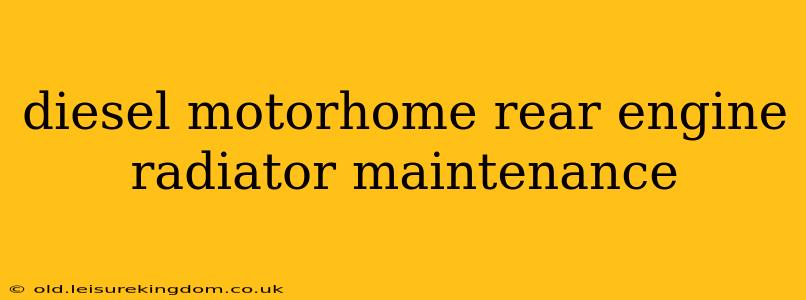Maintaining your diesel motorhome's rear-engine radiator is crucial for ensuring optimal engine performance, preventing overheating, and extending the lifespan of your vehicle. Because the radiator is often tucked away in a less accessible location, it's easy to overlook its importance. This comprehensive guide will walk you through essential maintenance tasks, troubleshooting common problems, and answering frequently asked questions.
What is the Purpose of a Rear Engine Radiator in a Diesel Motorhome?
The radiator's primary function is to dissipate heat from the engine coolant. In a diesel motorhome with a rear engine, this is especially critical because the engine compartment can get quite hot, and proper cooling is paramount to preventing engine damage. The rear-mounted radiator efficiently transfers heat away from the engine, preventing overheating even under heavy loads or in hot climates.
How Often Should I Inspect My Diesel Motorhome's Rear Engine Radiator?
Regular inspection is key. You should visually inspect your radiator at least every 3,000 miles or before each major trip. Look for signs of leaks, corrosion, damage from debris, or build-up of insects. A more thorough inspection, including checking coolant levels and pressure, should be conducted every 6,000 miles or semi-annually, whichever comes first.
How Do I Check the Coolant Level in My Rear Engine Radiator?
Checking the coolant level is simple but important. Locate your coolant reservoir (often a translucent tank near the radiator). With the engine cold, the coolant level should be within the designated "MIN" and "MAX" markers. If it's low, carefully add the correct type of coolant (consult your owner's manual). Never open the radiator cap when the engine is hot – the pressurized coolant can cause severe burns.
What are the Signs of a Failing Rear Engine Radiator?
Several indicators suggest potential problems with your rear-engine radiator:
- Overheating: This is the most obvious sign. Your engine temperature gauge will rise, potentially triggering warning lights.
- Coolant Leaks: Look for puddles under your motorhome, especially after parking for a period. Inspect hoses and connections for leaks as well.
- Low Coolant Level: Consistently low coolant levels, even after topping them up, indicate a leak somewhere in the system.
- White Smoke from Exhaust: White smoke can indicate coolant leaking into the combustion chambers.
- Pressure in the Coolant System: If the coolant system is consistently pressurized, it could signify a blockage or leak.
How Do I Clean My Diesel Motorhome's Rear Engine Radiator?
Cleaning the radiator is essential to prevent overheating. Build-up of debris, insects, and other contaminants can restrict airflow, reducing cooling efficiency. You can use a garden hose with a low-pressure nozzle to gently rinse the exterior of the radiator, ensuring you remove loose debris. For stubborn dirt, a specialized radiator cleaner might be necessary – follow the manufacturer’s instructions carefully. Never use high-pressure washers, as this can damage the radiator fins.
How Do I Flush My Diesel Motorhome's Cooling System?
Periodically flushing the entire cooling system is necessary to remove contaminants and prevent corrosion. This process involves draining the old coolant, rinsing the system with clean water, and refilling with fresh coolant. While this task can be performed by a professional, many DIY enthusiasts undertake this process. Always consult your owner's manual for specific instructions and the correct type and amount of coolant for your motorhome.
What are the Common Problems with Diesel Motorhome Rear Engine Radiators?
Common issues include:
- Leaks: Cracks, corrosion, or damaged hoses can lead to coolant leaks.
- Clogged Radiator: Restricted airflow due to debris buildup reduces cooling efficiency.
- Faulty Water Pump: A malfunctioning water pump can hinder coolant circulation.
- Thermostat Issues: A faulty thermostat can prevent the engine from reaching optimal operating temperature.
How Much Does Rear Engine Radiator Repair Cost?
Repair costs vary significantly depending on the extent of the damage, the accessibility of the radiator, and labor costs. A simple repair, like replacing a hose, might cost a few hundred dollars, while a complete radiator replacement could cost several thousand.
By diligently following this maintenance guide, you can significantly extend the lifespan of your diesel motorhome's rear-engine radiator, ensuring safe and reliable operation for many years to come. Remember to always consult your owner's manual for specific instructions and recommendations.

